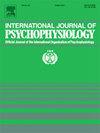The neural mechanisms of emotional flexibility influenced by the emotional valence shift direction and preparation effect
IF 2.5
3区 心理学
Q3 NEUROSCIENCES
引用次数: 0
Abstract
Emotional flexibility refers to an individual's ability to change emotional responses in constantly changing environments to adapt to different situations. This study aims to use the Emotional Switching Task (EST) paradigm, combined with Electroencephalogram (EEG) technology and behavioral experiments, to explore the impact of emotional valence shift directions and preparation effects on the switching cost of emotional flexibility. The results found that when individuals switch from positive emotional valence to positive emotional valence, the switching cost is smaller than other transition directions. In addition, emotional flexibility exhibits a preparation effect, with a 2000 ms preparation time resulting in a smaller switching cost than a 600 ms preparation time. The electrophysiological data, more specifically the N2, CNV, SPN and LPP components, reveal the neural mechanisms by which emotional valence shift direction and preparation time influence emotional flexibility across the three neural computational stages of emotion regulation. This study is beneficial for establishing a potential mechanism model for the switching cost of emotional flexibility.
情绪效价转移方向和准备效应影响情绪灵活性的神经机制。
情绪灵活性是指个体在不断变化的环境中改变情绪反应以适应不同情况的能力。本研究旨在运用情绪转换任务(EST)范式,结合脑电图(EEG)技术和行为实验,探讨情绪效价转移方向和准备效应对情绪灵活性转换成本的影响。结果发现,当个体从积极情绪效价向积极情绪效价转换时,其转换成本小于其他转换方向。此外,情绪灵活性表现出准备效应,2000 ms的准备时间比600 ms的准备时间产生更小的转换成本。电生理数据,特别是N2、CNV、SPN和LPP分量,揭示了情绪价移方向和准备时间在情绪调节的三个神经计算阶段影响情绪灵活性的神经机制。本研究有助于建立情绪灵活性转换成本的潜在机制模型。
本文章由计算机程序翻译,如有差异,请以英文原文为准。
求助全文
约1分钟内获得全文
求助全文
来源期刊
CiteScore
5.40
自引率
10.00%
发文量
177
审稿时长
3-8 weeks
期刊介绍:
The International Journal of Psychophysiology is the official journal of the International Organization of Psychophysiology, and provides a respected forum for the publication of high quality original contributions on all aspects of psychophysiology. The journal is interdisciplinary and aims to integrate the neurosciences and behavioral sciences. Empirical, theoretical, and review articles are encouraged in the following areas:
• Cerebral psychophysiology: including functional brain mapping and neuroimaging with Event-Related Potentials (ERPs), Positron Emission Tomography (PET), Functional Magnetic Resonance Imaging (fMRI) and Electroencephalographic studies.
• Autonomic functions: including bilateral electrodermal activity, pupillometry and blood volume changes.
• Cardiovascular Psychophysiology:including studies of blood pressure, cardiac functioning and respiration.
• Somatic psychophysiology: including muscle activity, eye movements and eye blinks.

 求助内容:
求助内容: 应助结果提醒方式:
应助结果提醒方式:


